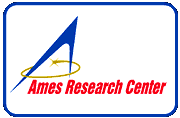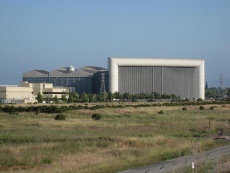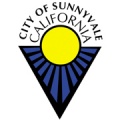Centro Ricerche Ames
Da Ufopedia.
| Questa voce ha bisogno di essere tradotta. |
NASA's Ames Research Center (ARC), located at Moffett Field, California, was founded on December 20, 1939 as the second National Advisory Committee for Aeronautics (NACA) laboratory, and became part of NASA in 1958, as part of the turnover from NACA. The center was named after Joseph Sweetman Ames, a founding member and longtime chairman (1919–1939) of the NACA.
Ames Research Center is one of NASA’s 10 major field centers and is located in California's Silicon Valley, near the high-tech companies, entrepreneurial ventures, universities, and other laboratories that fuel the region's reputation for technology development and research. With over $3.0 billion in capital equipment, 2,300 research personnel and a $600 million annual budget, Ames' economic impact is significant.
Historically, Ames was founded to do wind-tunnel research on the aerodynamics of propeller-driven aircraft; however, Ames has expanded its role to doing research and technology in aeronautics, spaceflight, and information technology. Ames plays a role in many of NASA missions in support of America's space and aeronautics programs. It provides leadership in astrobiology; small satellites; robotic lunar exploration; technologies for the Constellation Program; the search for habitable planets; supercomputing; intelligent/adaptive systems; advanced thermal protection; and airborne astronomy. Ames also develops tools for a safer, more efficient national airspace and unique partnerships benefiting NASA’s mission. The center's current director is Dr. Simon P. "Pete" Worden (Brigadier General, USAF Retired).
Ames is also a mission center for several key current NASA Science missions (Kepler Mission, Lunar CRater Observation and Sensing Satellite (LCROSS), Stratospheric Observatory for Infrared Astronomy (SOFIA)) and a major contributor to the new Exploration focus of the Agency as a participant in the Orion crew exploration vehicle, and the Ares I crew launch vehicle.Template:Update after
Indice |
Missions
Although Ames is a NASA Research Center, and not a flight center, nevertheless it has been closely involved in a number of astronomy and space missions.
Lunar Prospector was the third mission selected by NASA for full development and construction as part of the Discovery Program. At a cost of $62.8 million, the 19-month mission was put into a low polar orbit of the Moon, accomplishing mapping of surface composition and possible polar ice deposits, measurements of magnetic and gravity fields, and study of lunar outgassing events. Based on Lunar Prospector Neutron Spectrometer (NS) data, mission scientists have determined that there is indeed water ice in the polar craters of the Moon.[1] The mission ended July 31, 1999 when the orbiter was guided to an impact into a crater near the lunar south pole in an (unsuccessful) attempt to analyze lunar polar water by vaporizing it to allow spectroscopic characterization from Earth telescopes.
The 11-pound (5-kilogram) GeneSat-1, carrying bacteria inside a miniature laboratory, was launched on Dec. 16, 2006. The very small NASA satellite has proven that scientists can quickly design and launch a new class of inexpensive spacecraft—and conduct significant science.[2]
The Lunar CRater Observation and Sensing Satellite (LCROSS) mission to look for water on the moon was a 'secondary payload spacecraft.' LCROSS began its trip to the moon on the same rocket as the Lunar Reconnaissance Orbiter (LRO), which continues to conduct a different lunar task. It launched in April 2009 on an Atlas V rocket from Kennedy Space Center, Florida.
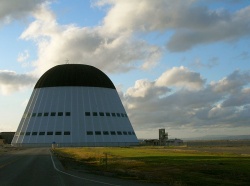
Kepler is NASA's first mission capable of finding Earth-size and smaller planets. The Kepler mission will monitor the brightness of stars to find planets that pass in front of them during the planets' orbits. During such passes or 'transits,' the planets will slightly decrease the star's brightness.
Stratospheric Observatory for Infrared Astronomy (SOFIA) is a joint venture of the U.S. and German aerospace agencies, NASA and the DLR to make an infrared telescope platform that can fly at altitudes high enough to be in the infrared-transparent regime above the water vapor in the Earth's atmosphere. The aircraft is supplied by the U.S., and the infrared telescope by Germany. Modifications of the Boeing 747SP airframe to accommodate the telescope, mission-unique equipment and large external door were made by L-3 Communications Integrated Systems of Waco, Texas.
The upcoming Lunar Atmosphere Dust Environment Explorer (LADEE) mission has been assigned to NASA Ames. This is planned for a launch to the Moon in 2011. In addition, Ames has played a support role in a number of missions, most notably the Mars Pathfinder and Mars Exploration Rover missions, where the Ames Intelligent Robotics Laboratory[3] played a key role. NASA Ames was a partner on the Mars Phoenix, a Mars Scout Program mission to send a high-latitude lander to Mars, deployed a robotic arm to dig trenches up to 1.6 feet (one half meter) into the layers of water ice and analyzing the soil composition. Ames is also a partner on the Mars Science Laboratory, a next generation Mars rover to explore for signs of organics and complex molecules.
Information technology
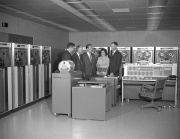
Ames is the home of NASA's large research and development divisions in Advanced Supercomputing, Human Factors, and Intelligent Systems or Artificial Intelligence. These Research & Development organizations support NASA's Exploration efforts, as well as the continued operations of the Space Shuttle and International Space Station, and the space science and Aeronautics work across NASA. The center also runs and maintains the E Root nameserver of the DNS System.
The Intelligent Systems Division (often called Code TI) is NASA's leading R&D Division developing advanced intelligent software and systems for all of NASA Mission Directorates. It provides software expertise for Aeronautics, Space Science Missions, Space Shuttle, International Space Station, and the new crewed Exploration Missions (CEV, and Ares). The first AI in space (Deep Space 1) was developed from Code TI, as is the MAPGEN software that daily plans the activities for the Mars Exploration Rovers, the same core reasoner is used for Ensemble to operate Phoenix Lander, and the planning system for the International Space Station's Solar Arrays. Integrated System Health Management for the International Space Station's control moment gyroscopes, collaborative systems with semantic search tools, and robust software engineering round out the scope of Code TI's work.
The Human Systems Integration Division[4] (called Code TH) advances human-centered design and operations of complex aerospace systems through analysis, experimentation, and modeling of human performance and human-automation interaction to make dramatic improvements in safety, efficiency and mission success. For decades, the Human Systems Integration Division has been on the leading edge of human-centered aerospace research. The Division is home to over 100 researchers, contractors and administrative staff.
Ames operates one of the world′s fastest supercomputers, Pleiades, which will be further enhanced and is scheduled to reach 10 petaflops of processing power by 2012.
In September 2009, Ames launched NEBULA as a fast and powerful Cloud Computing Platform to handle NASA's massive data sets that complied with security requirements.[5] This innovative pilot uses open-source components, complies with FISMA and can scale to Government-sized demands while being extremely energy efficient.
Image processing
NASA Ames was one of the first locations in the world to conduct research on image processing of satellite-platform aerial photography. Some of the pioneering techniques of contrast enhancement using Fourier analysis were developed at Ames in conjunction with researchers at ESL Inc.
Wind tunnels
The NASA Ames Research Center wind tunnels are known not only for their immense size, but also for their diverse characteristics that enable various kinds of scientific and engineering research.
ARC Unitary Plan Wind Tunnel The Unitary Plan Wind Tunnel (UPWT) was completed in 1956 at a cost of $27 million under the Unitary Plan Act of 1949. Since its completion, the UPWT facility has been the most heavily used NASA wind tunnel. Every major commercial transport and almost every military jet built in the United States over the last 40 years has been tested in this facility. The Mercury, Gemini, and Apollo capsules and the Space Shuttle were also tested in this tunnel complex. This wind tunnel facility represents a unique national asset of vital importance to the nation's defense and its competitive position in the world aerospace market.
National Full-Scale Aerodynamics Complex (NFAC) Ames Research Center also houses the world's largest wind tunnel, part of the National Full-Scale Aerodynamic Complex (NFAC): it is large enough to test full-sized planes, rather than scale models.
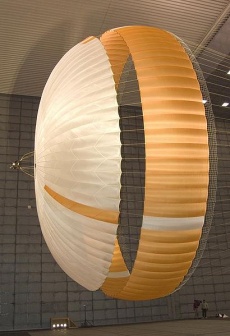
The 40 by 80 foot wind tunnel circuit was originally constructed in the 1940s and is now capable of providing test velocites up to Template:Convert. It is used to support an active research program in aerodynamics, dynamics, model noise, and full-scale aircraft and their components. The aerodynamic characteristics of new configurations are investigated with an emphasis on validating computational methods. Aeromechanical stability boundaries of advanced rotorcraft and rotor-fuselage interactions are explored. Stability and control derivatives are also determined, including the static and dynamic characteristics of new aircraft configurations. The acoustic characteristics of most of the full-scale vehicles are also determined, as well as acoustic research aimed at discovering and reducing aerodynamic sources of noise. In addition to the normal data gathering methods (e.g., balance system, pressure measuring transducers, and temperature sensing thermocouples), state-of-the-art, non-intrusive instrumentation (e.g., laser velocimeters and shadowgraphs) are available to help determine flow direction and velocity in and around the lifting surfaces of models or aircraft undergoing investigation. The 40 by 80 Foot Wind Tunnel is primarily used for determining the low- and medium-speed aerodynamic characteristics of high-performance aircraft, rotorcraft, and fixed wing, powered-lift V/STOL aircraft.
The 80 by 120 Foot Wind Tunnel at NASA Ames Research Center holds the distinction of being the largest wind tunnel test section in the world. This open circuit leg was added and a new fan drive system was installed in the 1980s. The 80 by 120 Foot Wind Tunnel is used to support an active research program in aerodynamics, dynamics, model noise, and full-scale aircraft and their components. The aerodynamic characteristics of new configurations are investigated, with an emphasis on validating computational methods. Aeromechanical stability boundaries of advanced rotorcraft and rotor-fuselage interactions are explored. The acoustic characteristics of most of the full-scale vehicles are also determined, as well as acoustic research aimed at discovering and reducing aerodynamic sources of noise. In addition to the normal data gathering methods (e.g., balance system, pressure measuring transducers, and temperature sensing thermocouples), state-of-the-art non-intrusive instrumentation (e.g., laser velocimeters and shadowgraphs) are available to help determine flow direction and velocity in and around the lifting surfaces of models or aircraft undergoing investigation. Some of the test programs that have come through the 80 by 120 Foot include: F-18 High Angle of Attack Vehicle, DARPA/Lockheed Common Affordable Lightweight Fighter, XV-15 Tilt Rotor, and Advance Recovery System Parafoil. The 80 by 120 foot test section is capable of testing a full size Boeing 737 at velocities up to Template:Convert.
Although decommissioned by NASA in 2003, the NFAC is now being operated by the United States Air Force as a satellite facility of the Arnold Engineering Development Center (AEDC).
Arc jet complex
The Ames Arc Jet Complex has seven available test bays. At the present time, four bays contain Arc Jet units of differing configurations, serviced by common facility support equipment. These are the Aerodynamic Heating Facility (AHF), the Turbulent Flow Duct (TFD), the Panel Test Facility (PTF), and the Interaction Heating Facility (IHF). The support equipment includes two D.C. power supplies, a steam ejector-driven vacuum system, a water-cooling system, high-pressure gas systems, data acquisition system, and other auxiliary systems.
The magnitude and capacity of these systems makes the Ames Arc Jet Complex unique in the world. The largest power supply can deliver 75 megawatts(MW) for a 30 minute duration or 150 MW for a 15 second duration. This power capacity, in combination with a high-volume 5-stage steam ejector vacuum-pumping system, enables facility operations to match high-altitude atmospheric flight conditions with samples of relatively large size. The Thermo-Physics Facilities Branch operates four arc jet facilities. The Interaction Heating Facility IHF), with an available power of over 60-MW, is one of the highest-power arc jets available. It is a very flexible facility, capable of long run times of up to one hour, and able to test large samples in both a stagnation and flat plate configuration. The Panel Test Facility (PTF) uses a unique semielliptic nozzle for testing panel sections. Powered by a 20-MW arc heater, the PTF can perform tests on samples for up to 20 minutes. The Turbulent Flow Duct provides supersonic, turbulent high temperature air flows over flat surfaces. The TFD is powered by a 20-MW Hüls arc heater and can test samples Template:Convert in size. The Aerodynamic Heating Facility (AHF) has similar characteristics to the IHF arc heater, offering a wide range of operating conditions, samples sizes and extended test times. A cold-air-mixing plenum allows for simulations of ascent or high-speed flight conditions. Catalycity studies using air or nitrogen can be performed in this flexible rig. A 5-arm model support system allows the user to maximize testing efficiency. The AHF can be configured with either a Hüls or segmented arc heater, up to 20-MW. 1 MW is enough power to supply 750 homes.
Range complex
The Ames Vertical Gun Range (AVGR) was designed to conduct scientific studies of lunar impact processes in support of the Apollo missions. In 1979, it was established as a National Facility, funded through the Planetary Geology and Geophysics Program. In 1995, increased scientific needs across various disciplines resulted in joint core funding by three different science programs at NASA Headquarters (Planetary Geology and Geophysics, Exobiology, and Solar System Origins). In addition, the AVGR provides programmatic support for various proposed and ongoing planetary missions (e.g. Stardust, Deep Impact).
Using its 0.30 cal light-gas gun and powder gun, the AVGR can launch projectiles to velocities ranging from Template:Convert. By varying the gun’s angle of elevation with respect to the target vacuum chamber, impact angles from 0° to 90° relative to the gravitational vector are possible. This unique feature is extremely important in the study of crater formation processes.
The target chamber is approximately Template:Convert in diameter and height and can accommodate a wide variety of targets and mounting fixtures. It can maintain vacuum levels below Template:Convert, or can be back filled with various gases to simulate different planetary atmospheres. Impact events are typically recorded with high-speed video/film, or Particle Image Velocimetry (PIV).
The Hypervelocity Free-Flight (HFF) Range currently comprises two active facilities: the Aerodynamic Facility (HFFAF) and the Gun Development Facility (HFFGDF). The HFFAF is a combined Ballistic Range and Shock-tube Driven Wind Tunnel. Its primary purpose is to examine the aerodynamic characteristics and flow-field structural details of free-flying aeroballistic models.
The HFFAF has a test section equipped with 16 shadowgraph-imaging stations. Each station can be used to capture an orthogonal pair of images of a hypervelocity model in flight. These images, combined with the recorded flight time history, can be used to obtain critical aerodynamic parameters such as lift, drag, static and dynamic stability, flow characteristics, and pitching moment coefficients. For very high Mach number (M > 25) simulations, models can be launched into a counter-flowing gas stream generated by the shock tube. The facility can also be configured for hypervelocity impact testing and has an aerothermodynamic capability as well. The HFFAF is currently configured to operate the Template:Convert light gas gun in support of continuing thermal imaging and transition research for NASA's hypersonics program.
The HFFGDF is used for gun performance enhancement studies, and occasional impact testing. The Facility uses the same arsenal of light-gas and powder guns as the HFFAF to accelerate particles that range in size from Template:Convert diameter to velocities ranging from 0.5 to 8.5 km/s (1,500 to 28,000 ft/s). Most of the research effort to date has centered on Earth atmosphere entry configurations (Mercury, Gemini, Apollo, and Shuttle), planetary entry designs (Viking, Pioneer Venus, Galileo and MSL), and aerobraking (AFE) configurations. The facility has also been used for scramjet propulsion studies (National Aerospace Plane (NASP)) and meteoroid/orbital debris impact studies (Space Station and RLV). In 2004, the facility was utilized for foam-debris dynamics testing in support of the Return To Flight effort. As of March 2007, the GDF has been reconfigured to operate a cold gas gun for subsonic CEV capsule aerodynamics.
The Electric Arc Shock Tube (EAST) Facility is used to investigate the effects of radiation and ionization that occur during very high velocity atmospheric entries. In addition, the EAST can also provide air-blast simulations requiring the strongest possible shock generation in air at an initial pressure loading of Template:Convert or greater. The facility has three separate driver configurations, to meet a range of test requirements: the driver can be connected to a diaphragm station of either a Template:Convert or a Template:Convert shock tube, and the high-pressure Template:Convert shock tube can also drive a Template:Convert shock tunnel. Energy for the drivers is supplied by a 1.25-MJ-capacitor storage system.
Recent events
Although the Bush administration slightly increased funding for NASA overall, the substantial realignment in research priorities that followed the announcement of the Vision for Space Exploration in 2004 has led to a significant number of layoffs at Ames. As before, NASA has chosen to devote more resources to the more visible human-staffed space missions than to robot spacecraft or scientific experiments.
On September 28, 2005, both Google and Ames Research Center disclosed details to a long-term research partnership. In addition to pooling engineering talent, Google plans to build a Template:Convert facility on the ARC campus.[6] One of the projects between Ames, Google, and Carnegie Mellon University is the Gigapan Project—a robotic platform for creating, sharing, and annotating terrestrial gigapixel images. The Planetary Content Project seeks to integrate and improve the data that Google uses for its Google Moon and Google Mars projects.[7] On June 4, 2008 Google announced it had leased Template:Convert from NASA, at Moffett Field, for use as office space and employee housing.[8]
HP has become the first corporate affiliate of a new Bio-Info-Nano Research and Development Institute (BIN-RDI); a collaborative venture established by the University of California Santa Cruz and NASA, based at NASA Ames in Mountain View, CA. The Bio|Info|Nano R&D Institute is dedicated to creating scientific breakthroughs made possible by the convergence of biotechnology, information technology, and nanotechnology.
On October 22, 2006, NASA opened the Carl Sagan Center for the Study of Life in the Cosmos. The center will continue the work that Carl Sagan undertook during his lifetime, including the Search for Extraterrestrial Intelligence.
In 2008, the Lunar Orbiter Image Recovery Project (LOIRP) was given space in the old McDonalds (the building has since been renamed to McMoons) to digitize data tapes from the five 1966 and 1967 Lunar Orbiter spacecraft that were sent to the Moon.
In 2010, NASA scientists at the Fluid Mechanics Laboratory at NASA Ames Research Center in Mountain View, California, studied the aerodynamics of the Jabulani World Cup soccer ball, concluding that it tends to "knuckle under" at speeds of 45-50 miles per hour.[9] Aerospace engineer Rabi Mehta attributed this effect to asymmetric flow due to the ball's seam construction.
NASA Ames Exploration Center
The NASA Ames Exploration Center is a science museum and education center for NASA. There are displays and interactive exhibits about NASA technology, missions and space exploration. A moon rock, meteorite and other geologic samples are on display. The theater shows movies with footage from NASA's explorations of Mars and the planets, and about the contributions of the scientists at NASA Ames Research Center. The facility is free and open to the public. Hours: Tuesday – Friday: 10am – 1pm; Sat & Sun: Noon – 4pm.
Galleria immagini
See also
References
- ↑ Template:Citeweb
- ↑ GeneSat-1
- ↑ Intelligent Robotics Laboratory
- ↑ Human Systems Integration Division
- ↑ NASA Ames Research Center "NEBULA Cloud Computing Platform", Retrieved (January 17, 2010)
- ↑ NASA - NASA Takes Google on Journey into Space
- ↑ http://ti.arc.nasa.gov/projects/planetary/
- ↑ Template:Cite news
- ↑ NASA Scores Big With Student Soccer Players in the U.S.A. and Canada. 18 June 2010. Retrieved March 2011.
- Complete books online
- Adventures in Research: A History of Ames Research Center, 1940-1965 (NASA SP-4302, 1970)
- Atmosphere of Freedom: Sixty Years at the NASA Ames Research Center (NASA SP-4314, 2000)
- Flight Research at Ames, 1940-1997: Fifty-Seven Years of Development and Validation of Aeronautical Technology (NASA SP-3300, 1998)
- Searching the Horizon: A History of Ames Research Center 1940-1976 (NASA SP-4304, 1985)
External links
- Ames Research Center
- Ames Research Center twitter
- NASA Ames Exploration Center
- Astrochemical Laboratory
- NASA Research Park Academic Partners
- University Affiliated Research Center
